Business Markets and Innovation
VerifiedAdded on 2020/06/05
|11
|3088
|44
AI Summary
This assignment delves into the concepts of business markets, innovation, and financial viability. It examines how businesses operate within a market framework focused on procuring products and services used for manufacturing and operational efficiency. The analysis emphasizes the importance of business innovation as a driver of value creation for both stakeholders and the company itself. Furthermore, it explores the crucial aspect of financial viability, highlighting the need for generating sufficient income to sustain operations, manage debt, and facilitate growth while maintaining service quality.
Contribute Materials
Your contribution can guide someone’s learning journey. Share your
documents today.
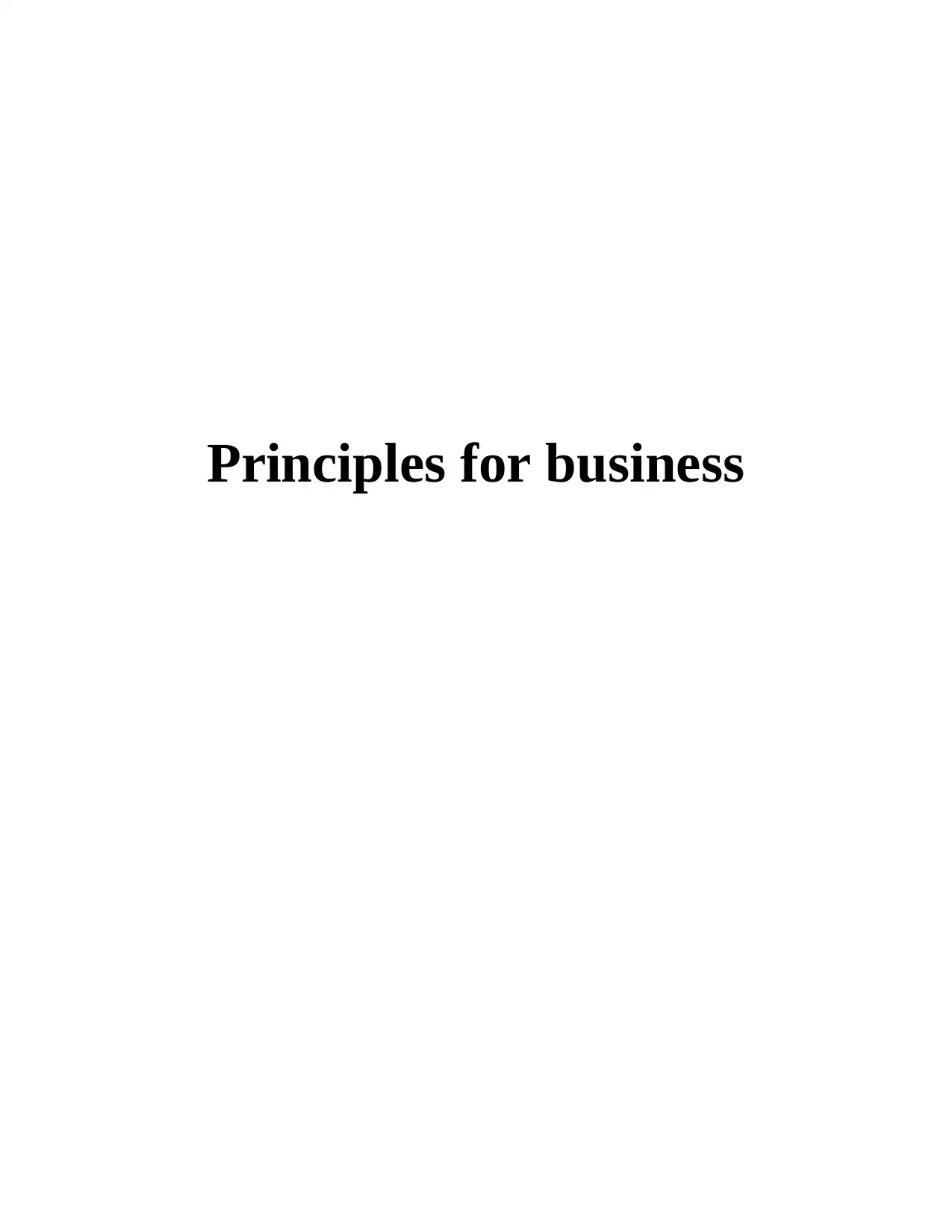
Principles for business
Secure Best Marks with AI Grader
Need help grading? Try our AI Grader for instant feedback on your assignments.
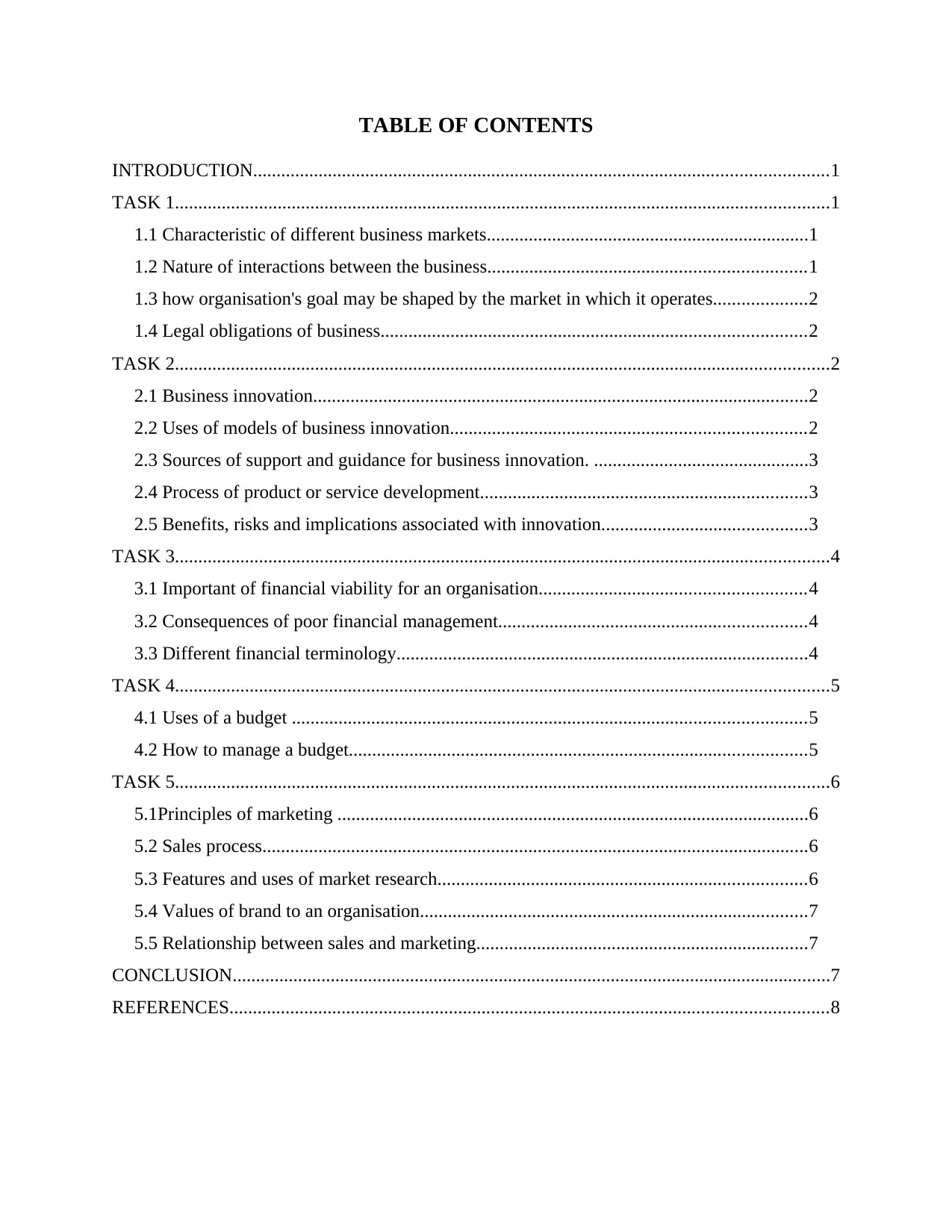
TABLE OF CONTENTS
INTRODUCTION...........................................................................................................................1
TASK 1............................................................................................................................................1
1.1 Characteristic of different business markets.....................................................................1
1.2 Nature of interactions between the business....................................................................1
1.3 how organisation's goal may be shaped by the market in which it operates....................2
1.4 Legal obligations of business...........................................................................................2
TASK 2............................................................................................................................................2
2.1 Business innovation..........................................................................................................2
2.2 Uses of models of business innovation............................................................................2
2.3 Sources of support and guidance for business innovation. ..............................................3
2.4 Process of product or service development......................................................................3
2.5 Benefits, risks and implications associated with innovation............................................3
TASK 3............................................................................................................................................4
3.1 Important of financial viability for an organisation.........................................................4
3.2 Consequences of poor financial management..................................................................4
3.3 Different financial terminology........................................................................................4
TASK 4............................................................................................................................................5
4.1 Uses of a budget ..............................................................................................................5
4.2 How to manage a budget..................................................................................................5
TASK 5............................................................................................................................................6
5.1Principles of marketing .....................................................................................................6
5.2 Sales process.....................................................................................................................6
5.3 Features and uses of market research...............................................................................6
5.4 Values of brand to an organisation...................................................................................7
5.5 Relationship between sales and marketing.......................................................................7
CONCLUSION................................................................................................................................7
REFERENCES................................................................................................................................8
INTRODUCTION...........................................................................................................................1
TASK 1............................................................................................................................................1
1.1 Characteristic of different business markets.....................................................................1
1.2 Nature of interactions between the business....................................................................1
1.3 how organisation's goal may be shaped by the market in which it operates....................2
1.4 Legal obligations of business...........................................................................................2
TASK 2............................................................................................................................................2
2.1 Business innovation..........................................................................................................2
2.2 Uses of models of business innovation............................................................................2
2.3 Sources of support and guidance for business innovation. ..............................................3
2.4 Process of product or service development......................................................................3
2.5 Benefits, risks and implications associated with innovation............................................3
TASK 3............................................................................................................................................4
3.1 Important of financial viability for an organisation.........................................................4
3.2 Consequences of poor financial management..................................................................4
3.3 Different financial terminology........................................................................................4
TASK 4............................................................................................................................................5
4.1 Uses of a budget ..............................................................................................................5
4.2 How to manage a budget..................................................................................................5
TASK 5............................................................................................................................................6
5.1Principles of marketing .....................................................................................................6
5.2 Sales process.....................................................................................................................6
5.3 Features and uses of market research...............................................................................6
5.4 Values of brand to an organisation...................................................................................7
5.5 Relationship between sales and marketing.......................................................................7
CONCLUSION................................................................................................................................7
REFERENCES................................................................................................................................8
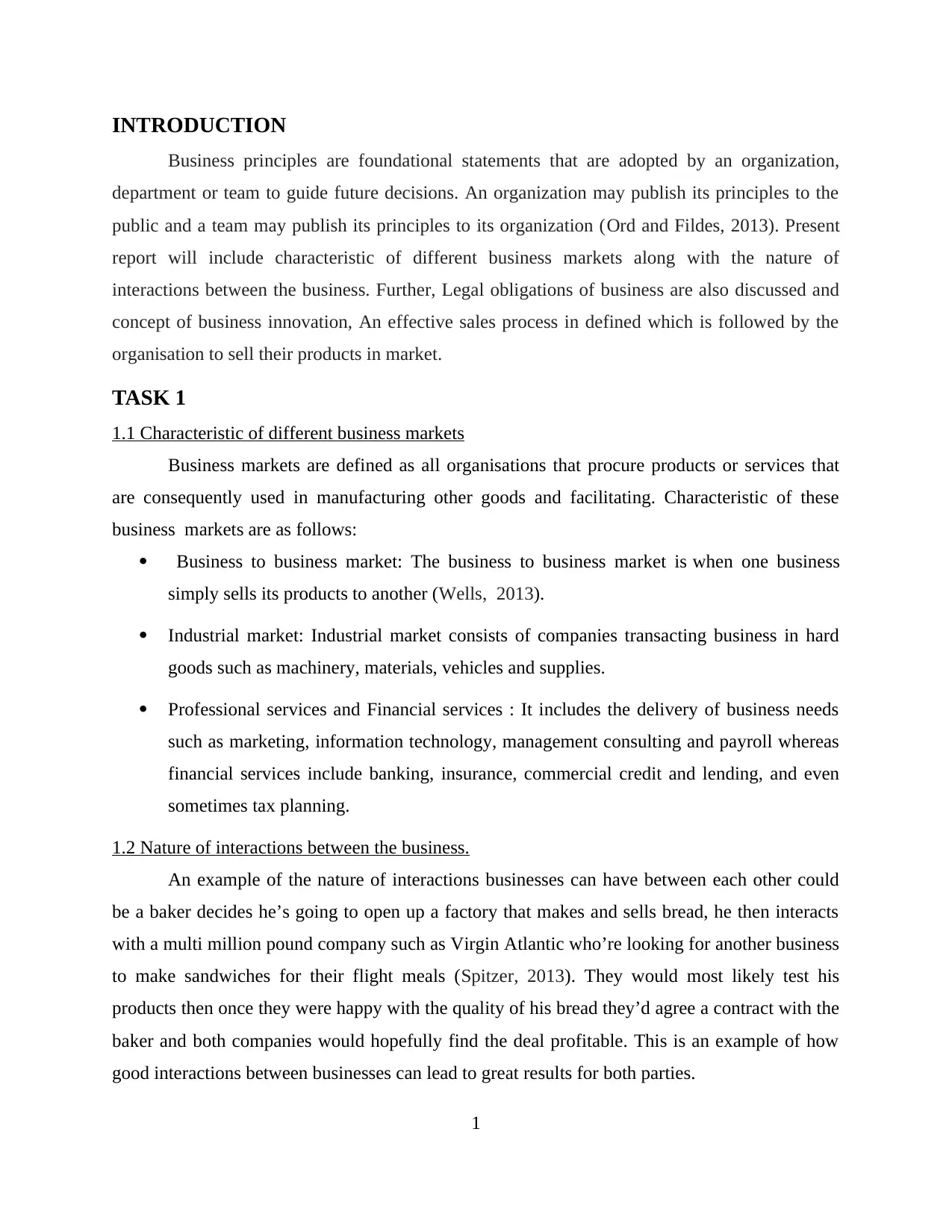
INTRODUCTION
Business principles are foundational statements that are adopted by an organization,
department or team to guide future decisions. An organization may publish its principles to the
public and a team may publish its principles to its organization (Ord and Fildes, 2013). Present
report will include characteristic of different business markets along with the nature of
interactions between the business. Further, Legal obligations of business are also discussed and
concept of business innovation, An effective sales process in defined which is followed by the
organisation to sell their products in market.
TASK 1
1.1 Characteristic of different business markets
Business markets are defined as all organisations that procure products or services that
are consequently used in manufacturing other goods and facilitating. Characteristic of these
business markets are as follows:
Business to business market: The business to business market is when one business
simply sells its products to another (Wells, 2013).
Industrial market: Industrial market consists of companies transacting business in hard
goods such as machinery, materials, vehicles and supplies.
Professional services and Financial services : It includes the delivery of business needs
such as marketing, information technology, management consulting and payroll whereas
financial services include banking, insurance, commercial credit and lending, and even
sometimes tax planning.
1.2 Nature of interactions between the business.
An example of the nature of interactions businesses can have between each other could
be a baker decides he’s going to open up a factory that makes and sells bread, he then interacts
with a multi million pound company such as Virgin Atlantic who’re looking for another business
to make sandwiches for their flight meals (Spitzer, 2013). They would most likely test his
products then once they were happy with the quality of his bread they’d agree a contract with the
baker and both companies would hopefully find the deal profitable. This is an example of how
good interactions between businesses can lead to great results for both parties.
1
Business principles are foundational statements that are adopted by an organization,
department or team to guide future decisions. An organization may publish its principles to the
public and a team may publish its principles to its organization (Ord and Fildes, 2013). Present
report will include characteristic of different business markets along with the nature of
interactions between the business. Further, Legal obligations of business are also discussed and
concept of business innovation, An effective sales process in defined which is followed by the
organisation to sell their products in market.
TASK 1
1.1 Characteristic of different business markets
Business markets are defined as all organisations that procure products or services that
are consequently used in manufacturing other goods and facilitating. Characteristic of these
business markets are as follows:
Business to business market: The business to business market is when one business
simply sells its products to another (Wells, 2013).
Industrial market: Industrial market consists of companies transacting business in hard
goods such as machinery, materials, vehicles and supplies.
Professional services and Financial services : It includes the delivery of business needs
such as marketing, information technology, management consulting and payroll whereas
financial services include banking, insurance, commercial credit and lending, and even
sometimes tax planning.
1.2 Nature of interactions between the business.
An example of the nature of interactions businesses can have between each other could
be a baker decides he’s going to open up a factory that makes and sells bread, he then interacts
with a multi million pound company such as Virgin Atlantic who’re looking for another business
to make sandwiches for their flight meals (Spitzer, 2013). They would most likely test his
products then once they were happy with the quality of his bread they’d agree a contract with the
baker and both companies would hopefully find the deal profitable. This is an example of how
good interactions between businesses can lead to great results for both parties.
1
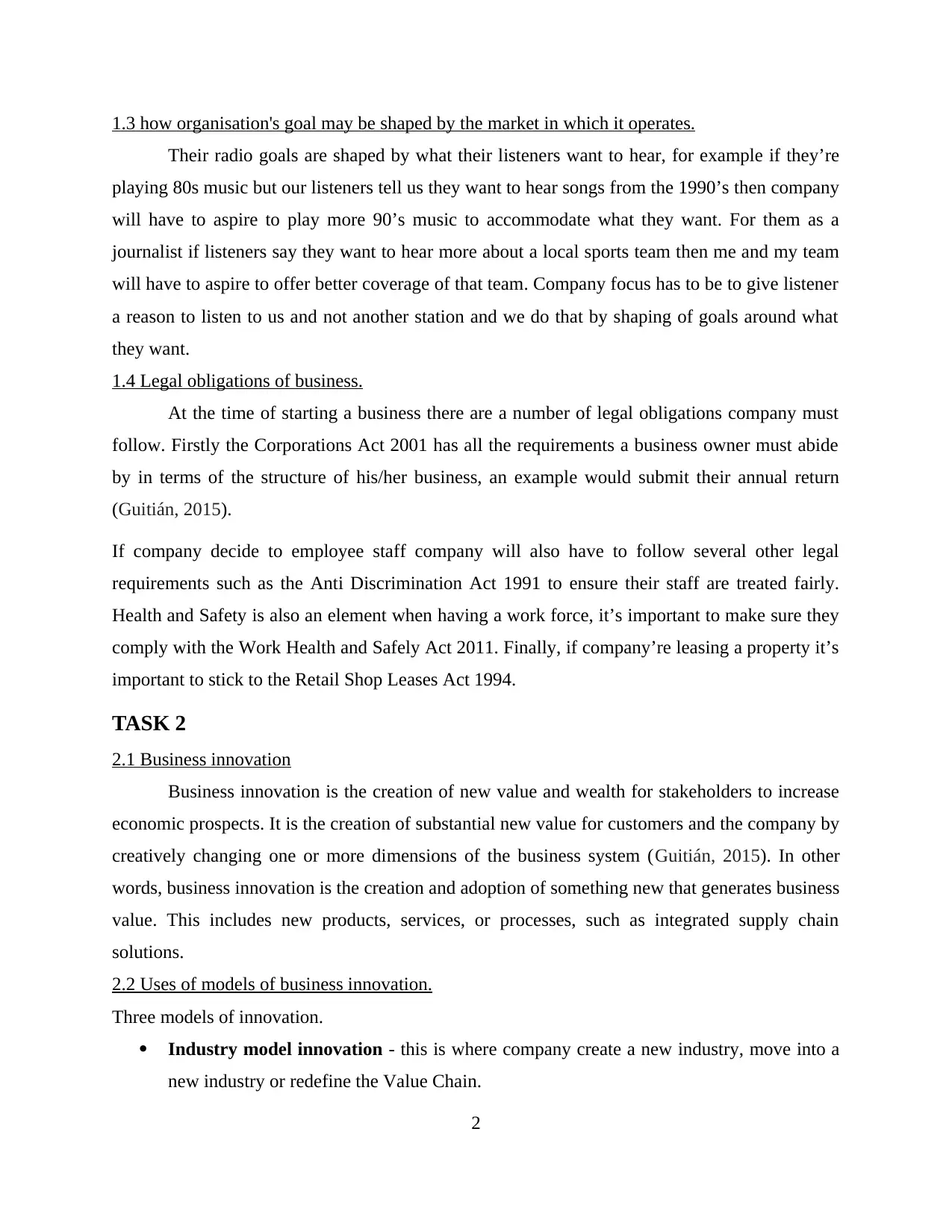
1.3 how organisation's goal may be shaped by the market in which it operates.
Their radio goals are shaped by what their listeners want to hear, for example if they’re
playing 80s music but our listeners tell us they want to hear songs from the 1990’s then company
will have to aspire to play more 90’s music to accommodate what they want. For them as a
journalist if listeners say they want to hear more about a local sports team then me and my team
will have to aspire to offer better coverage of that team. Company focus has to be to give listener
a reason to listen to us and not another station and we do that by shaping of goals around what
they want.
1.4 Legal obligations of business.
At the time of starting a business there are a number of legal obligations company must
follow. Firstly the Corporations Act 2001 has all the requirements a business owner must abide
by in terms of the structure of his/her business, an example would submit their annual return
(Guitián, 2015).
If company decide to employee staff company will also have to follow several other legal
requirements such as the Anti Discrimination Act 1991 to ensure their staff are treated fairly.
Health and Safety is also an element when having a work force, it’s important to make sure they
comply with the Work Health and Safely Act 2011. Finally, if company’re leasing a property it’s
important to stick to the Retail Shop Leases Act 1994.
TASK 2
2.1 Business innovation
Business innovation is the creation of new value and wealth for stakeholders to increase
economic prospects. It is the creation of substantial new value for customers and the company by
creatively changing one or more dimensions of the business system (Guitián, 2015). In other
words, business innovation is the creation and adoption of something new that generates business
value. This includes new products, services, or processes, such as integrated supply chain
solutions.
2.2 Uses of models of business innovation.
Three models of innovation.
Industry model innovation - this is where company create a new industry, move into a
new industry or redefine the Value Chain.
2
Their radio goals are shaped by what their listeners want to hear, for example if they’re
playing 80s music but our listeners tell us they want to hear songs from the 1990’s then company
will have to aspire to play more 90’s music to accommodate what they want. For them as a
journalist if listeners say they want to hear more about a local sports team then me and my team
will have to aspire to offer better coverage of that team. Company focus has to be to give listener
a reason to listen to us and not another station and we do that by shaping of goals around what
they want.
1.4 Legal obligations of business.
At the time of starting a business there are a number of legal obligations company must
follow. Firstly the Corporations Act 2001 has all the requirements a business owner must abide
by in terms of the structure of his/her business, an example would submit their annual return
(Guitián, 2015).
If company decide to employee staff company will also have to follow several other legal
requirements such as the Anti Discrimination Act 1991 to ensure their staff are treated fairly.
Health and Safety is also an element when having a work force, it’s important to make sure they
comply with the Work Health and Safely Act 2011. Finally, if company’re leasing a property it’s
important to stick to the Retail Shop Leases Act 1994.
TASK 2
2.1 Business innovation
Business innovation is the creation of new value and wealth for stakeholders to increase
economic prospects. It is the creation of substantial new value for customers and the company by
creatively changing one or more dimensions of the business system (Guitián, 2015). In other
words, business innovation is the creation and adoption of something new that generates business
value. This includes new products, services, or processes, such as integrated supply chain
solutions.
2.2 Uses of models of business innovation.
Three models of innovation.
Industry model innovation - this is where company create a new industry, move into a
new industry or redefine the Value Chain.
2
Secure Best Marks with AI Grader
Need help grading? Try our AI Grader for instant feedback on your assignments.
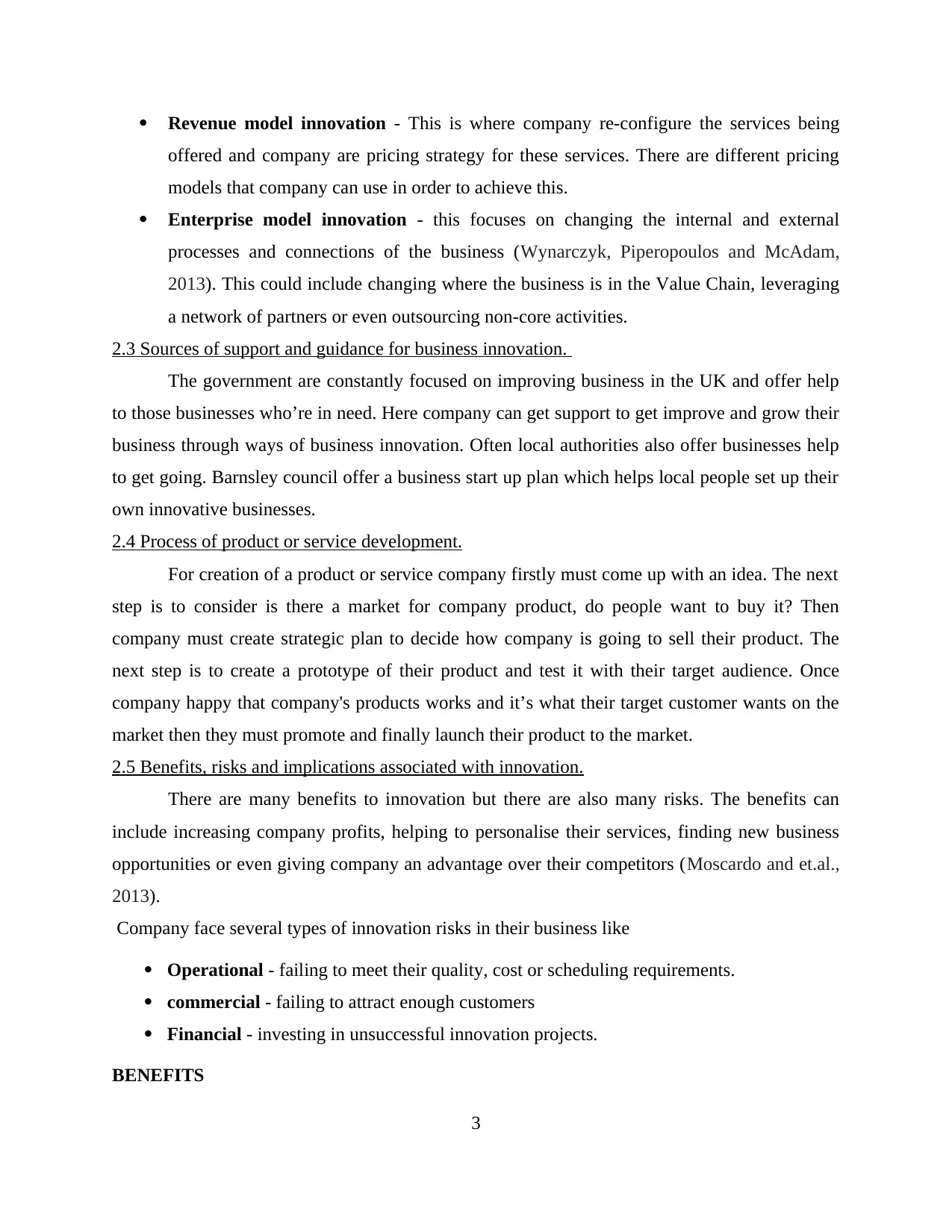
Revenue model innovation - This is where company re-configure the services being
offered and company are pricing strategy for these services. There are different pricing
models that company can use in order to achieve this.
Enterprise model innovation - this focuses on changing the internal and external
processes and connections of the business (Wynarczyk, Piperopoulos and McAdam,
2013). This could include changing where the business is in the Value Chain, leveraging
a network of partners or even outsourcing non-core activities.
2.3 Sources of support and guidance for business innovation.
The government are constantly focused on improving business in the UK and offer help
to those businesses who’re in need. Here company can get support to get improve and grow their
business through ways of business innovation. Often local authorities also offer businesses help
to get going. Barnsley council offer a business start up plan which helps local people set up their
own innovative businesses.
2.4 Process of product or service development.
For creation of a product or service company firstly must come up with an idea. The next
step is to consider is there a market for company product, do people want to buy it? Then
company must create strategic plan to decide how company is going to sell their product. The
next step is to create a prototype of their product and test it with their target audience. Once
company happy that company's products works and it’s what their target customer wants on the
market then they must promote and finally launch their product to the market.
2.5 Benefits, risks and implications associated with innovation.
There are many benefits to innovation but there are also many risks. The benefits can
include increasing company profits, helping to personalise their services, finding new business
opportunities or even giving company an advantage over their competitors (Moscardo and et.al.,
2013).
Company face several types of innovation risks in their business like
Operational - failing to meet their quality, cost or scheduling requirements.
commercial - failing to attract enough customers
Financial - investing in unsuccessful innovation projects.
BENEFITS
3
offered and company are pricing strategy for these services. There are different pricing
models that company can use in order to achieve this.
Enterprise model innovation - this focuses on changing the internal and external
processes and connections of the business (Wynarczyk, Piperopoulos and McAdam,
2013). This could include changing where the business is in the Value Chain, leveraging
a network of partners or even outsourcing non-core activities.
2.3 Sources of support and guidance for business innovation.
The government are constantly focused on improving business in the UK and offer help
to those businesses who’re in need. Here company can get support to get improve and grow their
business through ways of business innovation. Often local authorities also offer businesses help
to get going. Barnsley council offer a business start up plan which helps local people set up their
own innovative businesses.
2.4 Process of product or service development.
For creation of a product or service company firstly must come up with an idea. The next
step is to consider is there a market for company product, do people want to buy it? Then
company must create strategic plan to decide how company is going to sell their product. The
next step is to create a prototype of their product and test it with their target audience. Once
company happy that company's products works and it’s what their target customer wants on the
market then they must promote and finally launch their product to the market.
2.5 Benefits, risks and implications associated with innovation.
There are many benefits to innovation but there are also many risks. The benefits can
include increasing company profits, helping to personalise their services, finding new business
opportunities or even giving company an advantage over their competitors (Moscardo and et.al.,
2013).
Company face several types of innovation risks in their business like
Operational - failing to meet their quality, cost or scheduling requirements.
commercial - failing to attract enough customers
Financial - investing in unsuccessful innovation projects.
BENEFITS
3
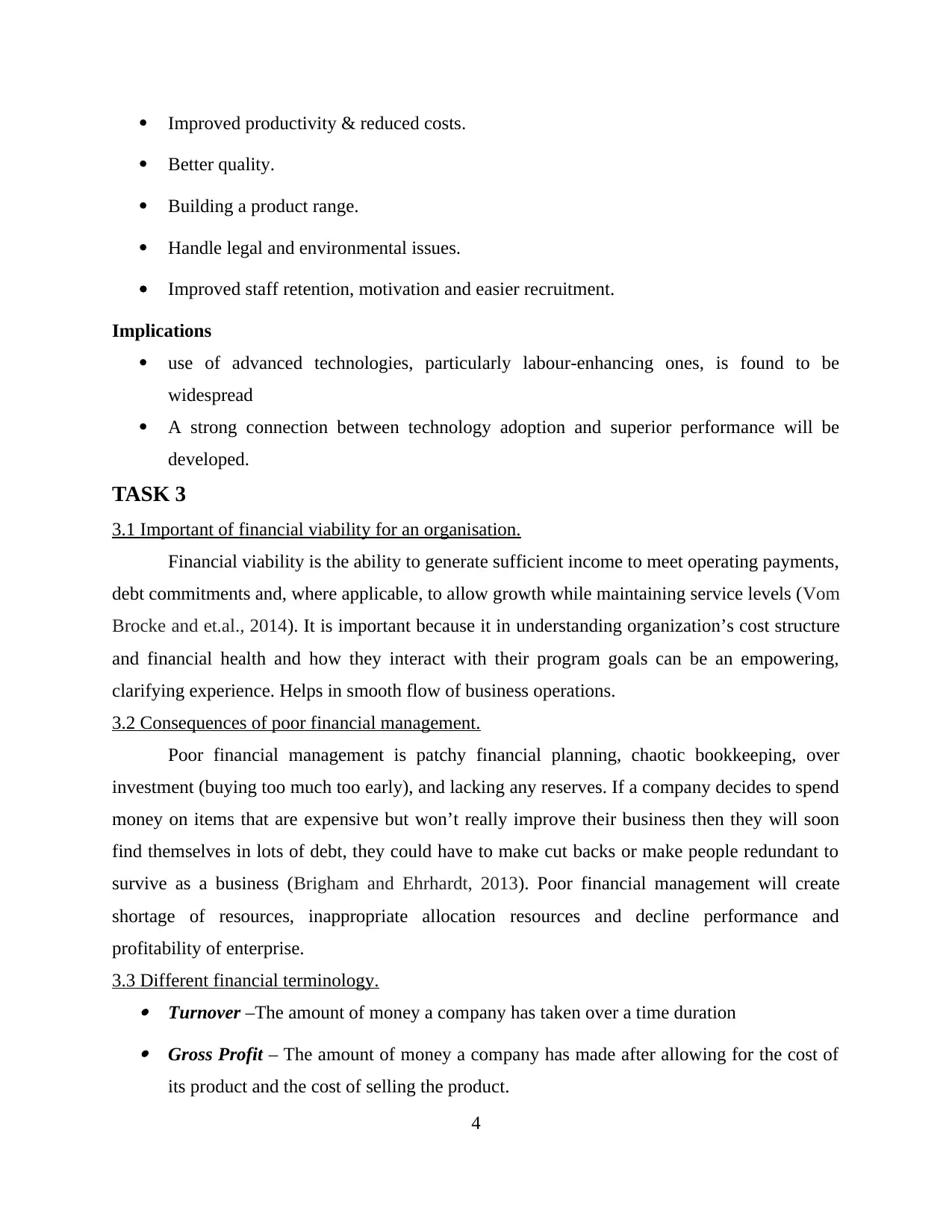
Improved productivity & reduced costs.
Better quality.
Building a product range.
Handle legal and environmental issues.
Improved staff retention, motivation and easier recruitment.
Implications
use of advanced technologies, particularly labour-enhancing ones, is found to be
widespread
A strong connection between technology adoption and superior performance will be
developed.
TASK 3
3.1 Important of financial viability for an organisation.
Financial viability is the ability to generate sufficient income to meet operating payments,
debt commitments and, where applicable, to allow growth while maintaining service levels (Vom
Brocke and et.al., 2014). It is important because it in understanding organization’s cost structure
and financial health and how they interact with their program goals can be an empowering,
clarifying experience. Helps in smooth flow of business operations.
3.2 Consequences of poor financial management.
Poor financial management is patchy financial planning, chaotic bookkeeping, over
investment (buying too much too early), and lacking any reserves. If a company decides to spend
money on items that are expensive but won’t really improve their business then they will soon
find themselves in lots of debt, they could have to make cut backs or make people redundant to
survive as a business (Brigham and Ehrhardt, 2013). Poor financial management will create
shortage of resources, inappropriate allocation resources and decline performance and
profitability of enterprise.
3.3 Different financial terminology. Turnover –The amount of money a company has taken over a time duration Gross Profit – The amount of money a company has made after allowing for the cost of
its product and the cost of selling the product.
4
Better quality.
Building a product range.
Handle legal and environmental issues.
Improved staff retention, motivation and easier recruitment.
Implications
use of advanced technologies, particularly labour-enhancing ones, is found to be
widespread
A strong connection between technology adoption and superior performance will be
developed.
TASK 3
3.1 Important of financial viability for an organisation.
Financial viability is the ability to generate sufficient income to meet operating payments,
debt commitments and, where applicable, to allow growth while maintaining service levels (Vom
Brocke and et.al., 2014). It is important because it in understanding organization’s cost structure
and financial health and how they interact with their program goals can be an empowering,
clarifying experience. Helps in smooth flow of business operations.
3.2 Consequences of poor financial management.
Poor financial management is patchy financial planning, chaotic bookkeeping, over
investment (buying too much too early), and lacking any reserves. If a company decides to spend
money on items that are expensive but won’t really improve their business then they will soon
find themselves in lots of debt, they could have to make cut backs or make people redundant to
survive as a business (Brigham and Ehrhardt, 2013). Poor financial management will create
shortage of resources, inappropriate allocation resources and decline performance and
profitability of enterprise.
3.3 Different financial terminology. Turnover –The amount of money a company has taken over a time duration Gross Profit – The amount of money a company has made after allowing for the cost of
its product and the cost of selling the product.
4
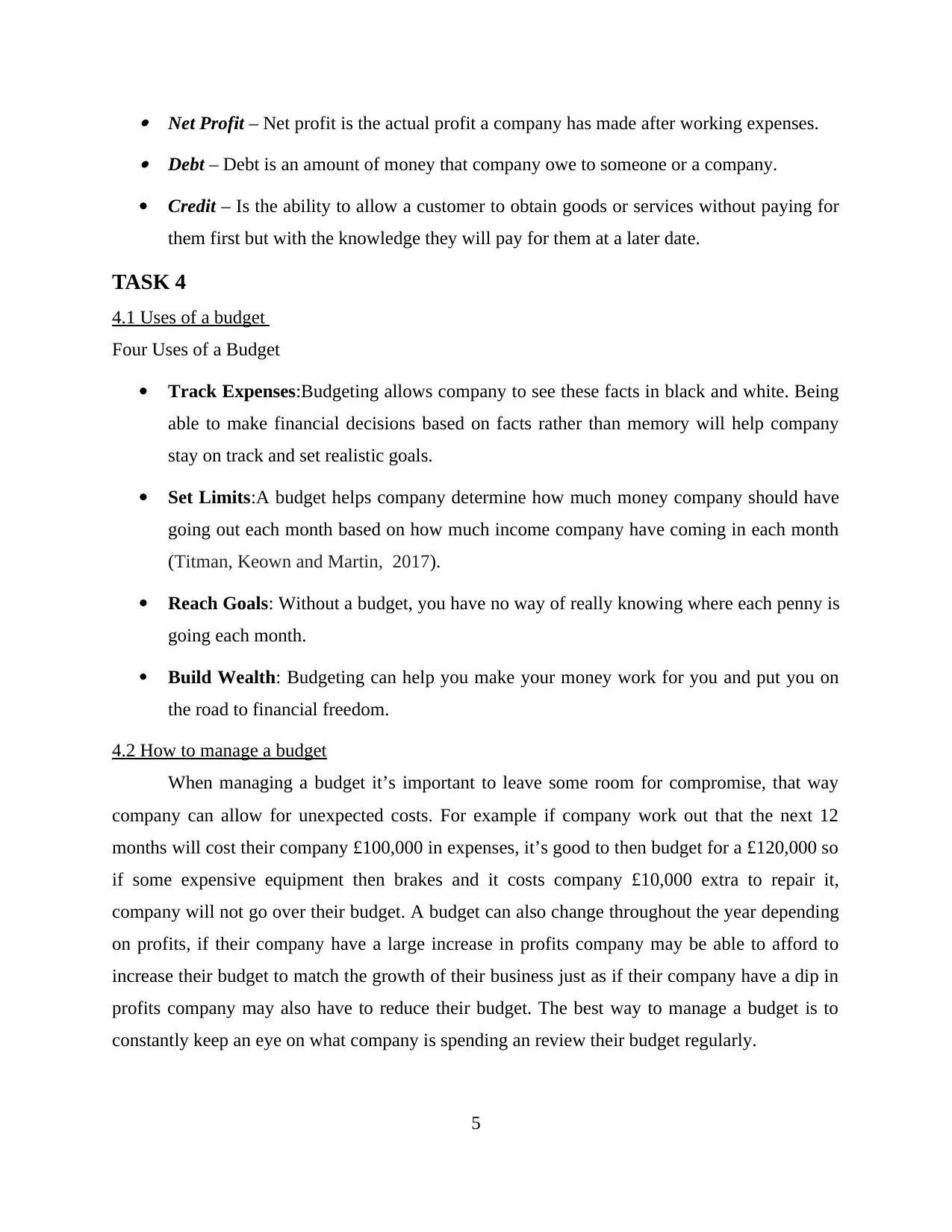
Net Profit – Net profit is the actual profit a company has made after working expenses. Debt – Debt is an amount of money that company owe to someone or a company.
Credit – Is the ability to allow a customer to obtain goods or services without paying for
them first but with the knowledge they will pay for them at a later date.
TASK 4
4.1 Uses of a budget
Four Uses of a Budget
Track Expenses:Budgeting allows company to see these facts in black and white. Being
able to make financial decisions based on facts rather than memory will help company
stay on track and set realistic goals.
Set Limits:A budget helps company determine how much money company should have
going out each month based on how much income company have coming in each month
(Titman, Keown and Martin, 2017).
Reach Goals: Without a budget, you have no way of really knowing where each penny is
going each month.
Build Wealth: Budgeting can help you make your money work for you and put you on
the road to financial freedom.
4.2 How to manage a budget
When managing a budget it’s important to leave some room for compromise, that way
company can allow for unexpected costs. For example if company work out that the next 12
months will cost their company £100,000 in expenses, it’s good to then budget for a £120,000 so
if some expensive equipment then brakes and it costs company £10,000 extra to repair it,
company will not go over their budget. A budget can also change throughout the year depending
on profits, if their company have a large increase in profits company may be able to afford to
increase their budget to match the growth of their business just as if their company have a dip in
profits company may also have to reduce their budget. The best way to manage a budget is to
constantly keep an eye on what company is spending an review their budget regularly.
5
Credit – Is the ability to allow a customer to obtain goods or services without paying for
them first but with the knowledge they will pay for them at a later date.
TASK 4
4.1 Uses of a budget
Four Uses of a Budget
Track Expenses:Budgeting allows company to see these facts in black and white. Being
able to make financial decisions based on facts rather than memory will help company
stay on track and set realistic goals.
Set Limits:A budget helps company determine how much money company should have
going out each month based on how much income company have coming in each month
(Titman, Keown and Martin, 2017).
Reach Goals: Without a budget, you have no way of really knowing where each penny is
going each month.
Build Wealth: Budgeting can help you make your money work for you and put you on
the road to financial freedom.
4.2 How to manage a budget
When managing a budget it’s important to leave some room for compromise, that way
company can allow for unexpected costs. For example if company work out that the next 12
months will cost their company £100,000 in expenses, it’s good to then budget for a £120,000 so
if some expensive equipment then brakes and it costs company £10,000 extra to repair it,
company will not go over their budget. A budget can also change throughout the year depending
on profits, if their company have a large increase in profits company may be able to afford to
increase their budget to match the growth of their business just as if their company have a dip in
profits company may also have to reduce their budget. The best way to manage a budget is to
constantly keep an eye on what company is spending an review their budget regularly.
5
Paraphrase This Document
Need a fresh take? Get an instant paraphrase of this document with our AI Paraphraser
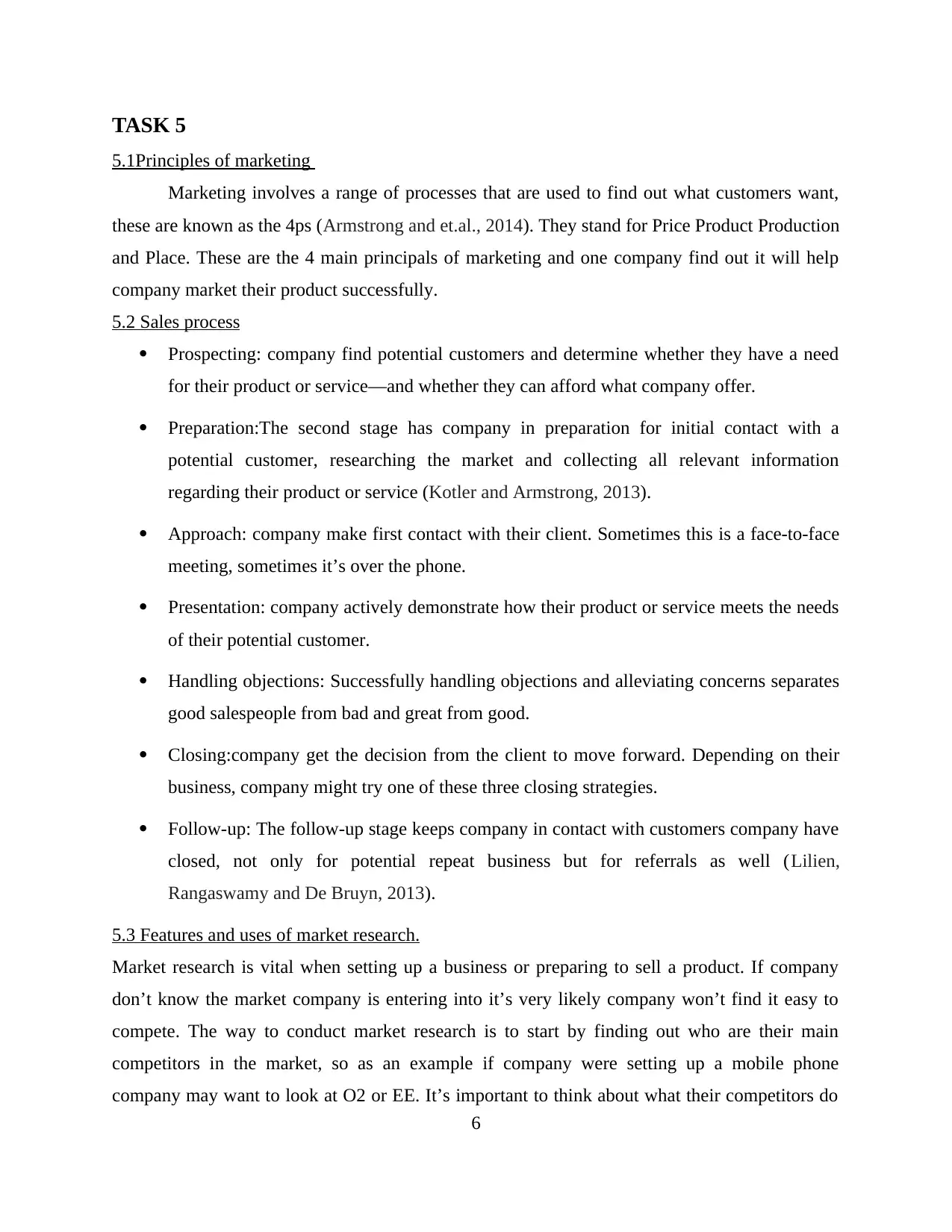
TASK 5
5.1Principles of marketing
Marketing involves a range of processes that are used to find out what customers want,
these are known as the 4ps (Armstrong and et.al., 2014). They stand for Price Product Production
and Place. These are the 4 main principals of marketing and one company find out it will help
company market their product successfully.
5.2 Sales process
Prospecting: company find potential customers and determine whether they have a need
for their product or service—and whether they can afford what company offer.
Preparation:The second stage has company in preparation for initial contact with a
potential customer, researching the market and collecting all relevant information
regarding their product or service (Kotler and Armstrong, 2013).
Approach: company make first contact with their client. Sometimes this is a face-to-face
meeting, sometimes it’s over the phone.
Presentation: company actively demonstrate how their product or service meets the needs
of their potential customer.
Handling objections: Successfully handling objections and alleviating concerns separates
good salespeople from bad and great from good.
Closing:company get the decision from the client to move forward. Depending on their
business, company might try one of these three closing strategies.
Follow-up: The follow-up stage keeps company in contact with customers company have
closed, not only for potential repeat business but for referrals as well (Lilien,
Rangaswamy and De Bruyn, 2013).
5.3 Features and uses of market research.
Market research is vital when setting up a business or preparing to sell a product. If company
don’t know the market company is entering into it’s very likely company won’t find it easy to
compete. The way to conduct market research is to start by finding out who are their main
competitors in the market, so as an example if company were setting up a mobile phone
company may want to look at O2 or EE. It’s important to think about what their competitors do
6
5.1Principles of marketing
Marketing involves a range of processes that are used to find out what customers want,
these are known as the 4ps (Armstrong and et.al., 2014). They stand for Price Product Production
and Place. These are the 4 main principals of marketing and one company find out it will help
company market their product successfully.
5.2 Sales process
Prospecting: company find potential customers and determine whether they have a need
for their product or service—and whether they can afford what company offer.
Preparation:The second stage has company in preparation for initial contact with a
potential customer, researching the market and collecting all relevant information
regarding their product or service (Kotler and Armstrong, 2013).
Approach: company make first contact with their client. Sometimes this is a face-to-face
meeting, sometimes it’s over the phone.
Presentation: company actively demonstrate how their product or service meets the needs
of their potential customer.
Handling objections: Successfully handling objections and alleviating concerns separates
good salespeople from bad and great from good.
Closing:company get the decision from the client to move forward. Depending on their
business, company might try one of these three closing strategies.
Follow-up: The follow-up stage keeps company in contact with customers company have
closed, not only for potential repeat business but for referrals as well (Lilien,
Rangaswamy and De Bruyn, 2013).
5.3 Features and uses of market research.
Market research is vital when setting up a business or preparing to sell a product. If company
don’t know the market company is entering into it’s very likely company won’t find it easy to
compete. The way to conduct market research is to start by finding out who are their main
competitors in the market, so as an example if company were setting up a mobile phone
company may want to look at O2 or EE. It’s important to think about what their competitors do
6
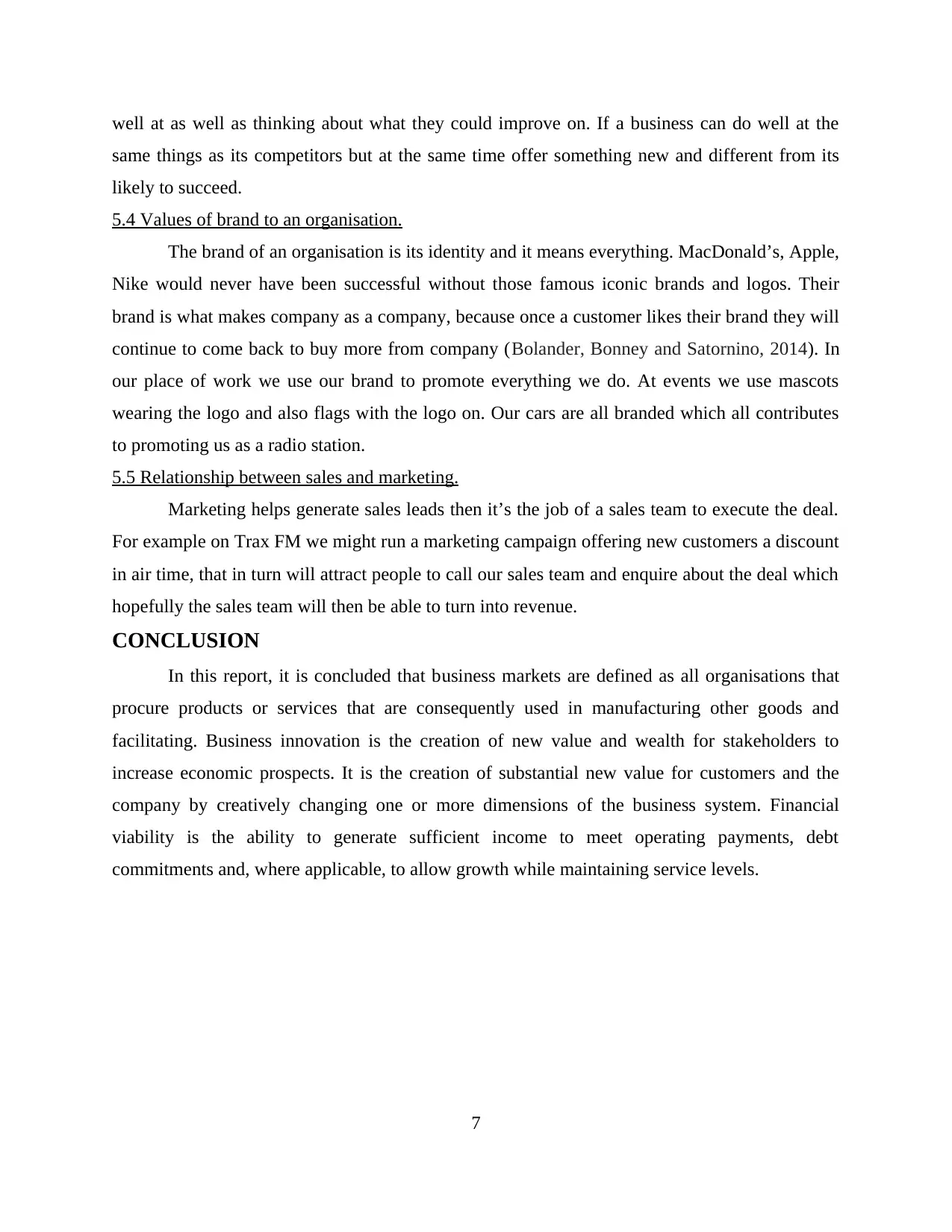
well at as well as thinking about what they could improve on. If a business can do well at the
same things as its competitors but at the same time offer something new and different from its
likely to succeed.
5.4 Values of brand to an organisation.
The brand of an organisation is its identity and it means everything. MacDonald’s, Apple,
Nike would never have been successful without those famous iconic brands and logos. Their
brand is what makes company as a company, because once a customer likes their brand they will
continue to come back to buy more from company (Bolander, Bonney and Satornino, 2014). In
our place of work we use our brand to promote everything we do. At events we use mascots
wearing the logo and also flags with the logo on. Our cars are all branded which all contributes
to promoting us as a radio station.
5.5 Relationship between sales and marketing.
Marketing helps generate sales leads then it’s the job of a sales team to execute the deal.
For example on Trax FM we might run a marketing campaign offering new customers a discount
in air time, that in turn will attract people to call our sales team and enquire about the deal which
hopefully the sales team will then be able to turn into revenue.
CONCLUSION
In this report, it is concluded that business markets are defined as all organisations that
procure products or services that are consequently used in manufacturing other goods and
facilitating. Business innovation is the creation of new value and wealth for stakeholders to
increase economic prospects. It is the creation of substantial new value for customers and the
company by creatively changing one or more dimensions of the business system. Financial
viability is the ability to generate sufficient income to meet operating payments, debt
commitments and, where applicable, to allow growth while maintaining service levels.
7
same things as its competitors but at the same time offer something new and different from its
likely to succeed.
5.4 Values of brand to an organisation.
The brand of an organisation is its identity and it means everything. MacDonald’s, Apple,
Nike would never have been successful without those famous iconic brands and logos. Their
brand is what makes company as a company, because once a customer likes their brand they will
continue to come back to buy more from company (Bolander, Bonney and Satornino, 2014). In
our place of work we use our brand to promote everything we do. At events we use mascots
wearing the logo and also flags with the logo on. Our cars are all branded which all contributes
to promoting us as a radio station.
5.5 Relationship between sales and marketing.
Marketing helps generate sales leads then it’s the job of a sales team to execute the deal.
For example on Trax FM we might run a marketing campaign offering new customers a discount
in air time, that in turn will attract people to call our sales team and enquire about the deal which
hopefully the sales team will then be able to turn into revenue.
CONCLUSION
In this report, it is concluded that business markets are defined as all organisations that
procure products or services that are consequently used in manufacturing other goods and
facilitating. Business innovation is the creation of new value and wealth for stakeholders to
increase economic prospects. It is the creation of substantial new value for customers and the
company by creatively changing one or more dimensions of the business system. Financial
viability is the ability to generate sufficient income to meet operating payments, debt
commitments and, where applicable, to allow growth while maintaining service levels.
7
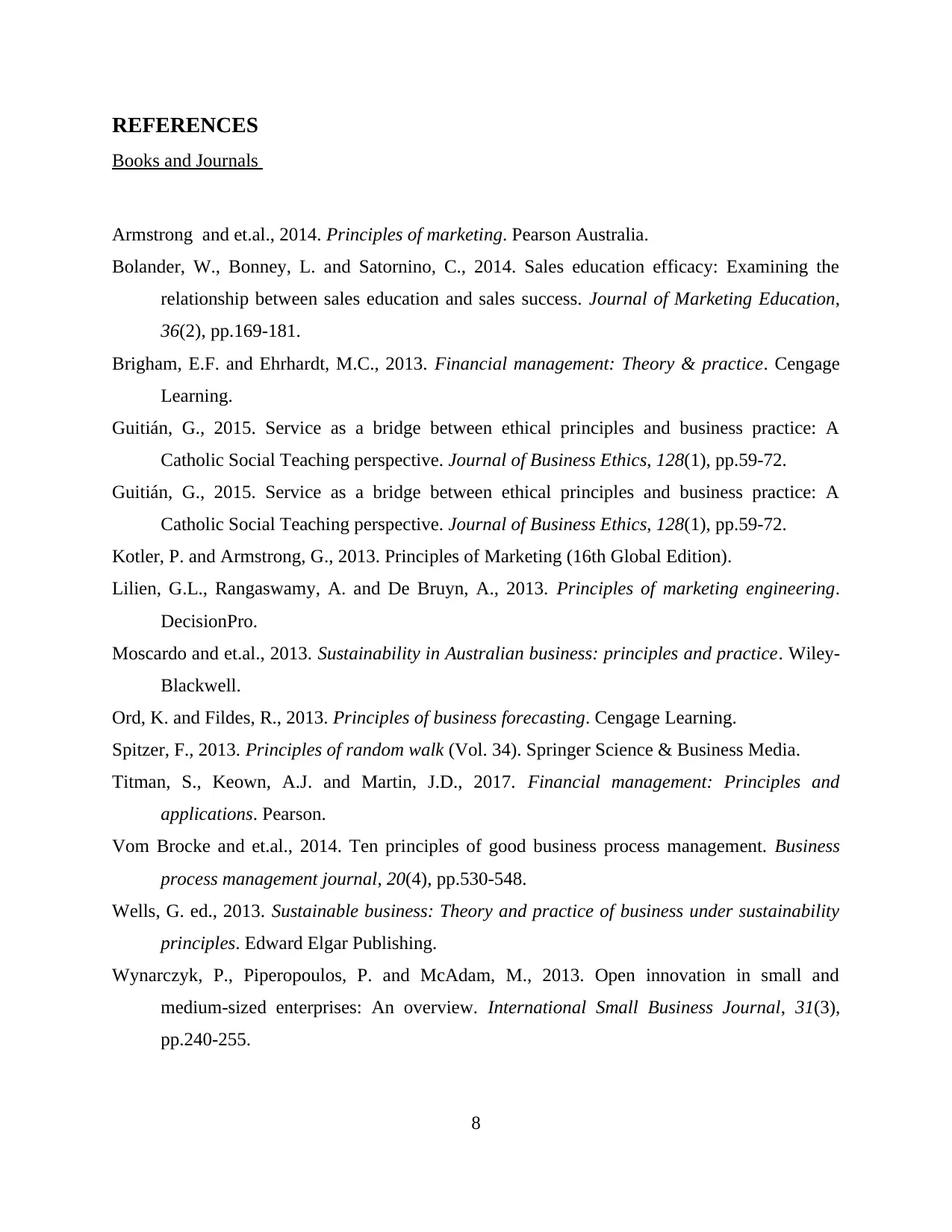
REFERENCES
Books and Journals
Armstrong and et.al., 2014. Principles of marketing. Pearson Australia.
Bolander, W., Bonney, L. and Satornino, C., 2014. Sales education efficacy: Examining the
relationship between sales education and sales success. Journal of Marketing Education,
36(2), pp.169-181.
Brigham, E.F. and Ehrhardt, M.C., 2013. Financial management: Theory & practice. Cengage
Learning.
Guitián, G., 2015. Service as a bridge between ethical principles and business practice: A
Catholic Social Teaching perspective. Journal of Business Ethics, 128(1), pp.59-72.
Guitián, G., 2015. Service as a bridge between ethical principles and business practice: A
Catholic Social Teaching perspective. Journal of Business Ethics, 128(1), pp.59-72.
Kotler, P. and Armstrong, G., 2013. Principles of Marketing (16th Global Edition).
Lilien, G.L., Rangaswamy, A. and De Bruyn, A., 2013. Principles of marketing engineering.
DecisionPro.
Moscardo and et.al., 2013. Sustainability in Australian business: principles and practice. Wiley-
Blackwell.
Ord, K. and Fildes, R., 2013. Principles of business forecasting. Cengage Learning.
Spitzer, F., 2013. Principles of random walk (Vol. 34). Springer Science & Business Media.
Titman, S., Keown, A.J. and Martin, J.D., 2017. Financial management: Principles and
applications. Pearson.
Vom Brocke and et.al., 2014. Ten principles of good business process management. Business
process management journal, 20(4), pp.530-548.
Wells, G. ed., 2013. Sustainable business: Theory and practice of business under sustainability
principles. Edward Elgar Publishing.
Wynarczyk, P., Piperopoulos, P. and McAdam, M., 2013. Open innovation in small and
medium-sized enterprises: An overview. International Small Business Journal, 31(3),
pp.240-255.
8
Books and Journals
Armstrong and et.al., 2014. Principles of marketing. Pearson Australia.
Bolander, W., Bonney, L. and Satornino, C., 2014. Sales education efficacy: Examining the
relationship between sales education and sales success. Journal of Marketing Education,
36(2), pp.169-181.
Brigham, E.F. and Ehrhardt, M.C., 2013. Financial management: Theory & practice. Cengage
Learning.
Guitián, G., 2015. Service as a bridge between ethical principles and business practice: A
Catholic Social Teaching perspective. Journal of Business Ethics, 128(1), pp.59-72.
Guitián, G., 2015. Service as a bridge between ethical principles and business practice: A
Catholic Social Teaching perspective. Journal of Business Ethics, 128(1), pp.59-72.
Kotler, P. and Armstrong, G., 2013. Principles of Marketing (16th Global Edition).
Lilien, G.L., Rangaswamy, A. and De Bruyn, A., 2013. Principles of marketing engineering.
DecisionPro.
Moscardo and et.al., 2013. Sustainability in Australian business: principles and practice. Wiley-
Blackwell.
Ord, K. and Fildes, R., 2013. Principles of business forecasting. Cengage Learning.
Spitzer, F., 2013. Principles of random walk (Vol. 34). Springer Science & Business Media.
Titman, S., Keown, A.J. and Martin, J.D., 2017. Financial management: Principles and
applications. Pearson.
Vom Brocke and et.al., 2014. Ten principles of good business process management. Business
process management journal, 20(4), pp.530-548.
Wells, G. ed., 2013. Sustainable business: Theory and practice of business under sustainability
principles. Edward Elgar Publishing.
Wynarczyk, P., Piperopoulos, P. and McAdam, M., 2013. Open innovation in small and
medium-sized enterprises: An overview. International Small Business Journal, 31(3),
pp.240-255.
8
Secure Best Marks with AI Grader
Need help grading? Try our AI Grader for instant feedback on your assignments.

9
1 out of 11
Related Documents
Your All-in-One AI-Powered Toolkit for Academic Success.
+13062052269
info@desklib.com
Available 24*7 on WhatsApp / Email
![[object Object]](/_next/static/media/star-bottom.7253800d.svg)
Unlock your academic potential
© 2024 | Zucol Services PVT LTD | All rights reserved.





